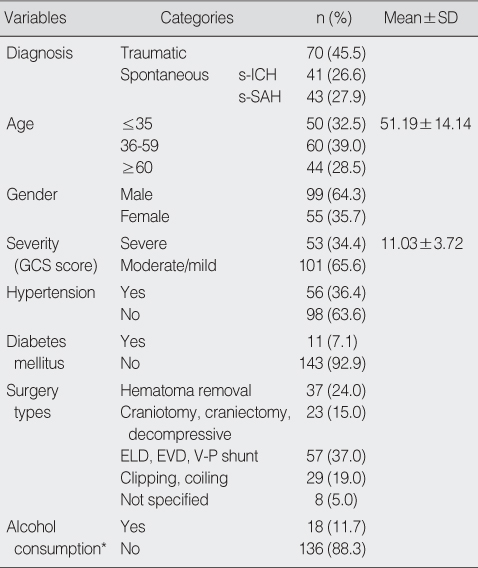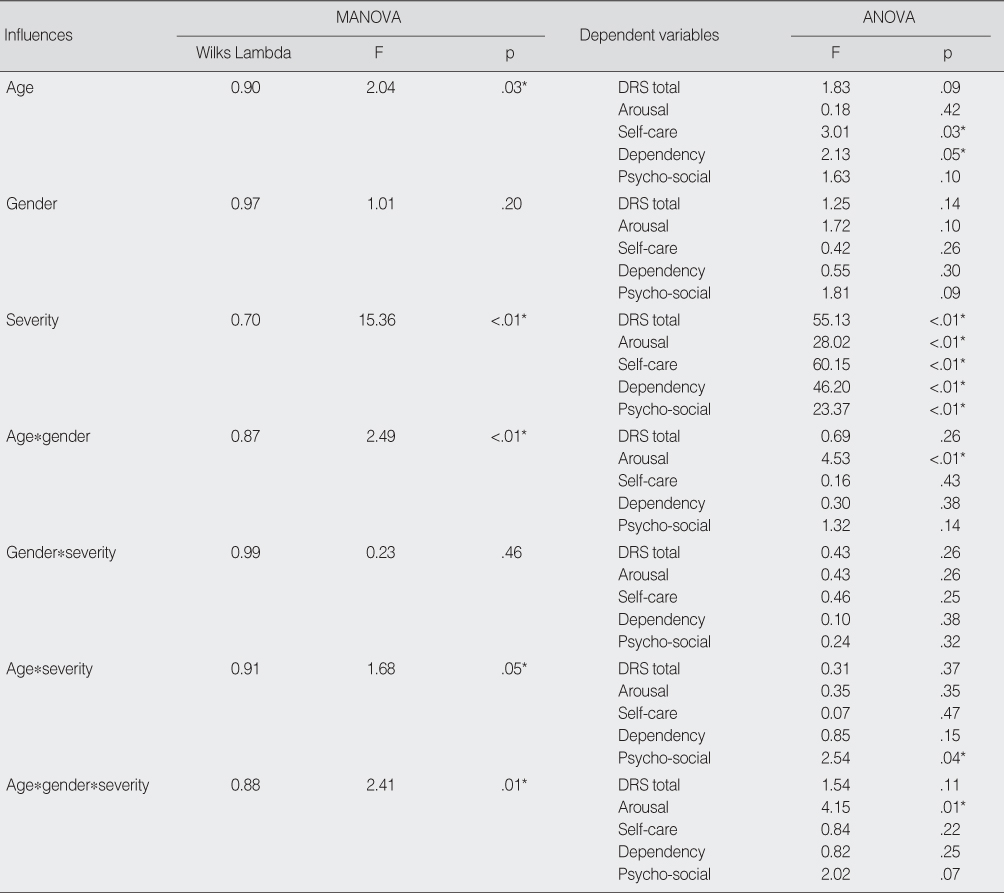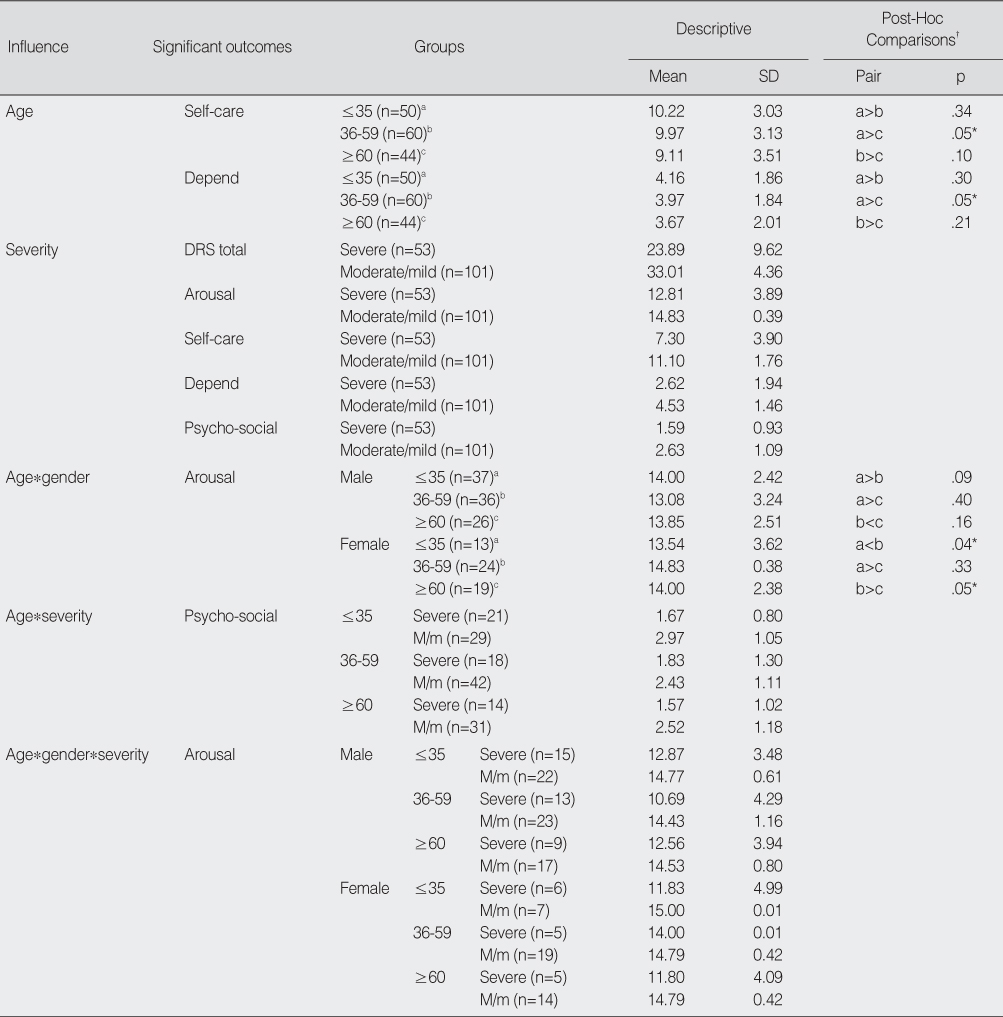Articles
- Page Path
- HOME > J Korean Acad Nurs > Volume 38(6); 2008 > Article
-
Original Article
- Influence of Age, Gender, and Severity on Recovery of Patients with Brain Injury
- Hyun Soo Oh, Wha Sook Seo
-
Journal of Korean Academy of Nursing 2008;38(6):923-932.
DOI: https://doi.org/10.4040/jkan.2008.38.6.923
Published online: December 31, 2008
Professor, Department of Nursing, Inha University, Incheon, Korea.
- Address reprint requests to: Oh, Hyun Soo. Department of Nursing, Inha University, 253 Younghyeon-dong, Nam-gu, Incheon 402-751, Korea. Tel: 82-32-860-8206, Fax: 82-32-874-5880, hsoh@inha.ac.kr
Copyright © 2008 Korean Society of Nursing Science
Abstract
-
Purpose
- This study was conducted to investigate the individual and cross influences of age, gender, and severity on recovery of patients with brain injury.
-
Methods
- For the purpose of the study, traumatic or spontaneous brain injury patients admitted to the intensive care unit (ICU) were conveniently selected. The data regarding outcomes were collected 3 months after admission.
-
Results
- Individual influences of the study variables on patients' recovery were significant, except for gender. But while the individual influence of gender on recovery was not significant, cross influence of gender and age was significant, but only for the sub-dimension of 'arousalbility and awareness'. The study results also showed that 3-way cross influence of gender, age, and severity was only significant on the sub-dimension of 'arousalbility and awareness'.
-
Conclusion
- The sub-dimension of recovery cross influenced by the demographic factors of gender and age, and severity was 'arousalbility and awareness'. This might indicate that the study variables that cross influencing recovery had more influence on consciousness compared to physical function and psycho-social adaptation.
- 1. Bahloul M, Chelly H, Ben Hmida M, Ben Hamida C, Ksibi H, Kallel H, et al. Prognosis of traumatic head injury in South Tunisia: A multivariate analysis of 437 cases. The Journal of Trauma. 2004;57:255–261.ArticlePubMed
- 2. Bakay RA, Ward AA. Enzymatic changes in serum and cerebrospinal fluid in neurological injury. Journal of Neurosurgery. 1983;58:27–37.ArticlePubMed
- 3. Burke TA, Venketasubramanian RN. The epidemiology of stroke in the East Asian region: A literature-based review. International Journal of Stroke. 2006;1:208–215.ArticlePubMedPDF
- 4. Chesnut R, Ghajar J, Maas AI. Management and prognosis of severe traumatic brain injury. Part 2: Early indicators of prognosis in severe traumatic brain injury. Journal of Neurotrauma. 2000;17:557–627.
- 5. Coimbra R, Hoyt DB, Potenza BM, Fortlage D, Hollingsworth-Fridlund P. Does sexual dimorphism influence outcome of traumatic brain injury patients? The answer is no! The Journal of Trauma. 2003;54:689–700.ArticlePubMed
- 6. Demetriades D, Kuncir E, Murray J, Velmahos GC, Rhee P, Chan L. Mortality prediction of head Abbreviated Injury Score and Glasgow Coma Scale: Analysis of 7,764 head injuries. Journal of the American College of Surgeons. 2004;199:216–222.PubMed
- 7. Gómez PA, Lobato RD, Boto GR, De la Lama A, González PJ, de la Cruz J. Age and outcome after severe head injury. Acta Neurochirurgica. 2000;142:373–381.ArticlePubMedPDF
- 8. Groswasser Z, Cohen M, Keren O. Female TBI patients recover better than males. Brain Injury. 1998;12:805–808.ArticlePubMed
- 9. Hukkelhoven CW, Steyerberg EW, Habbema JD, Farace E, Marmarou A, Murray GD, et al. Predicting outcome after traumatic brain injury: Development and validation of a prognostic score based on admission characteristics. Journal of Neurotrauma. 2005;22:1025–1039.ArticlePubMed
- 10. Hukkelhoven CW, Steyerberg EW, Rampen AJ, Farace E, Habbema JD, Marshall LF, et al. Patient age and outcome following severe traumatic brain injury: An analysis of 5,600 patients. Journal of Neurosurgery. 2003;99:666–673.ArticlePubMed
- 11. Jagger J, Jane JA, Rimel R. The Glasgow Coma Scale: To sum or not to sum? Lancet. 1983;2:97.
- 12. Jennet B, Teasdale G. Aspects of coma after severe head injury. Lancet. 1977;1:878–881.PubMed
- 13. Kim DR. The effect of somatosensory stimulation on recovery of the integrity of the somatosensory pathway after brain damage. Journal of Korean Academy of Nursing. 2004;34:1255–1264.ArticlePubMedPDF
- 14. Kimura D. Sex differences in the brain. Scientific American. 1992;267:118–125.ArticlePubMed
- 15. Laureys S, Piret S, Ledoux D. Quantifying consciousness. Lancet Neurology. 2005;4:789–790.ArticlePubMed
- 16. Marquez de la Plata CD, Hart T, Hammond FM, Frol AB, Hudak A, Harper CR, et al. Impact of age on long-term recovery from traumatic brain injury. Archives of Physical Medicine and Rehabilitation. 2008;89:896–903.ArticlePubMedPMC
- 17. Mosenthal AC, Livingston DH, Lavery RF, Knudson MM, Lee S, Morabito D, et al. The effect of age on functional outcome in mild traumatic brain injury: 6-month report of a prospective multicenter trial. The Journal of Trauma. 2004;56:1042–1048.ArticlePubMed
- 18. Mushkudiani NA, Engel DC, Steyerberg EW, Butcher I, Lu J, Marmarou A, et al. Prognostic value of demographic characteristics in traumatic brain injury: Results form the IMPACT study. Journal of Neurotrauma. 2007;24:259–269.ArticlePubMed
- 19. Oh HS, Kim YR, Seo WS, Seo YO. Development of an integrative cognitive rehabilitation program for brain injured patients in the post-acute stage. Journal of Korean Academy of Nursing. 2005;35:270–281.ArticlePubMedPDF
- 20. Rappaport M, Hall KM, Hopkins K, Belleza T, Cope DN. Disability rating scale for severe head trauma: Coma to Community. Archives of Physical Medicine and Rehabilitation. 1982;63:118–123.PubMed
- 21. Rovlias A, Kotsou S. Classification and regression tree for prediction of outcome after severe head injury using simple clinical and laboratory variables. Journal of Neurotrauma. 2004;21:886–893.ArticlePubMed
- 22. Rowley G, Fielding K. Reliability and accuracy of the Gasgow Coma Scale with experienced and inexperienced users. Lancet. 1991;337:535–538.PubMed
- 23. Samra SK, Giordani B, Caveney AF, Clarke WR, Scott PA, Anderson S, et al. Recovery of cognitive function after surgery for aneurysmal subarachnoid hemorrhage. Stroke. 2007;38:1864–1872.ArticlePubMed
- 24. Schreiber MA, Aoki N, Scott BG, Beck JR. Determinants of mortality in patients with severe blunt head injury. Archives of Surgery. 2002;137:285–290.ArticlePubMed
- 25. Stein DG, Hoffman SW. Estrogen and progesterone as neuroprotective agents in the treatment of acute brain injuries. Pediatric Rehabilitation. 2003;6:13–22.ArticlePubMed
- 26. Stein DG, Wright DW, Kellermann AL. Does progesterone have neuroprotective properties? Annals of Emergency Medicine. 2008;51:164–172.ArticlePubMed
- 27. Teasdale G, Jennett B. Assessment of coma and impaired consciousness. A practical scale. Lancet. 1974;2:81–84.PubMed
- 28. Thurman DJ, Alverson C, Dunn KA, Guerrero J, Sniezek JE. Traumatic brain injury in the United States: A public health perspective. Journal of Head Trauma Rehabilitation. 1999;14:602–615.ArticlePubMed
REFERENCES
Figure & Data
REFERENCES
Citations

- Development of Psychiatric Disorders after Mild Head Trauma according to Birth History
Ki Take Oh, Byung Ho Cha
Annals of Child Neurology.2025; 33(3): 85. CrossRef
Descriptive Statistics for Characteristics of Participants (N=154)
*Alcohol consumptional state at time of admission.
GCS=glasgow coma scale; ELD=extra-lesional drainage; EVD=extraventricular drainage; V-P shunt=ventricular peritoneum shunt.
Independent and Cross Influences of Age, Gender and Severity on Recovery of Patients with Brain Injury (N=154)
*one-tailed test, p≤0.05.
MANOVA=Multivariate Analysis of Variance; ANOVA=Analysis of Variance; Psycho-social=psycho-social adaptation (employment status).
Descriptive Statistics and Post-Hoc Comparisons of Significant Outcomes of Age, Gender, and Severity
*one-tailed test, p≤0.05; †Duncan test.
Depend=dependency on others; Psycho-social=psycho-social adaptation (employment status); M/m=moderate/mild.
*Alcohol consumptional state at time of admission. GCS=glasgow coma scale; ELD=extra-lesional drainage; EVD=extraventricular drainage; V-P shunt=ventricular peritoneum shunt.
*one-tailed test, p≤0.05. MANOVA=Multivariate Analysis of Variance; ANOVA=Analysis of Variance; Psycho-social=psycho-social adaptation (employment status).
*one-tailed test, p≤0.05; †Duncan test. Depend=dependency on others; Psycho-social=psycho-social adaptation (employment status); M/m=moderate/mild.
 KSNS
KSNS
 E-SUBMISSION
E-SUBMISSION



 Cite
Cite

